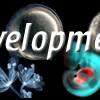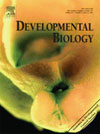





      |
|
James David Ebert (1921-2001)James D. Ebert and his wife of 55 years, Alma Goodwin Ebert, were killed in an automobile accident May 22. They were en route to their summer home in Woods Hole. Ebert played a long and distinguished role in developmental biology world wide. Jim was born in a small town in the coal mining area of Pennsylvania. After graduating from Washington and Jefferson College he entered the Navy in 1942. Ebert was a bona fide war hero. He was a lieutenant serving on a destroyer in the Pacific that was sunk by a suicide plane attack. Jim was rescued after many hours in the sea. He was the senior surviving officer and therefore assigned the responsibility of notifying the next of kin of those who died which was the majority of the crew. At the war office where he sought this information he was assisted by a young WAVE named Alma Goodwin. In 1946 Jim married Alma, and they moved to Baltimore where Jim entered graduate school in Biology at Johns Hopkins to study with the distinguished experimental embryologist Benjamin Willier. Jim's first job was at MIT. Soon Jim and Alma moved to the University of Indiana where Jim rose rapidly through the ranks. In 1956 the 3rd Director of the Dept. of Embryology of the Carnegie Institution of Washington, George Corner, retired. The Department had been established in 1914 at the Johns Hopkins Medical School. For the first 40 years it had been the world's center for research that described the anatomical development of human embryos, but anatomical embryology had run its course. The President of the Institution, Caryl Haskins, faced a serious decision. The Institution could close the Dept. of Embryology and divert resources elsewhere, a judgement that had been made for several other Departments. He made the decision to continue the Department in new directions, and Jim Ebert became the fourth Director at the age of 35. Ebert's first task was to move the Department to a new building on the Johns Hopkins Homewood campus which signified the shift of association from Pathology and Obstetrics to Biology. When he left the position 20 years later the Department's focus was entirely molecular and soon would become genetic. Ebert's research that brought him to the attention of the Institution used the tools of experimental embryology. As a graduate student he had become interested in the development of the immune system in chick embryos. The embryonic spleen responds dramatically to tissues transplanted to the chorioallantoic membrane, a phenomenon referred to as the graft versus host response. In the late 1950s Ebert and his colleagues studied this autoimmune reaction by altering the response with inhibitors and viral infection. His other early research interest was in muscle differentiation especially the influence of Rous sarcoma virus on this process. From the time that Ebert assumed the Directorship his major attention turned to building a strong Department of independent basic scientists and to national and international science policy. The list of organizations that he headed or served as trustee, advisory board appointments, panels, and corporate affiliations fills several pages. He had a long and close association with the Marine Biological Laboratory directing the embryology course in the early 1960s, and then President of the Laboratory from 1970 to 1978. He served as President of the Carnegie Institution of Washington from 1978 to 1987. Both the Carnegie Institution and the MBL benefited from his fund raising skills, and decisive leadership. During his career Ebert was President of eight professional societies, trustee of thirteen national and international organizations, and held appointment to some forty different advisory boards and committees of government agencies, and universities. At one time in his career Jim held the presidency or was on the Board of every national and international society concerned with developmental biology. The culmination of Jim's life of service began in 1981 when he was elected Vice-President of the National Academy of Sciences. At a memorial service for the Eberts, Frank Press, who was President of the Academy at the time, summed up Ebert's leadership of influential Academy committees. "Jim led in the 1981 reorganization of the National Research Council (the operating arm of the Academy); he chaired the Government-University-Industry Round Table which brought the top science agency heads together with industry and university leaders; he was in effect the scientific Director of the Infinite Voyage film series of the Academy which had a TV audience of millions and was awarded an Emmy; he kicked off the Academy involvement with K-12 science standards. Jim chaired the committee on Science and Creationism whose report was distributed to school boards across the country and figured in the amicus curiae that the Academy submitted to the Supreme Court. Jim was involved in problems of population growth and food and education in poor countries. All told he led or served on more than 20 different committees of the Academy including all of the important ones". Throughout his career Jim Ebert was especially concerned with promoting scientific interactions with Japan. Over the past 40 years more than 30 Japanese scientists spent time in the Department of Embryology as graduate students, postdoctoral fellows, or sabbatical workers including some of today's most distinguished Japanese scientists. Ebert traveled to Japan often to serve on advisory boards. More recently he developed a similar relationship with Chinese scientists. This recounting and listing of Jim's contributions does not do justice to the effect that he had on the career of many scientists including myself. Jim had a strictly hands off policy toward his students. Some sank and some swam, but Jim did not put his name on papers written by his graduate students. However, he supported individuals with enthusiasm. The tradition of reserving space in the Department for young investigators to try anything that they could imagine was begun by Jim. The independence of these young scientists was strictly observed. In summary, Jim Ebert's major contribution to 20th century biology was one of leadership. He directed others with common sense and intelligence removing obstacles so that scientists could mature and follow their own instincts. We have come to identify these principles with the highly successful administration of science that is practiced in the United States.
Donald D. Brown
|
 Developmental Biology Published by Elsevier Science under Auspices of Society for Developmental Biology |
|||
|
Page Modified:
|
News | About SDB | Membership | Meetings | Jobs | Education Interactive Fly | Publications | Virtual Library |
© Society for Developmental Biology |